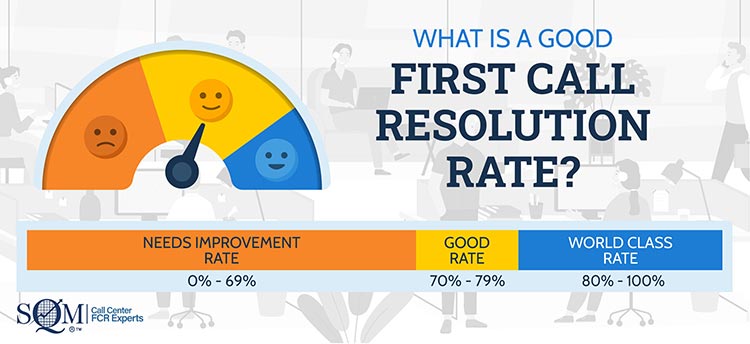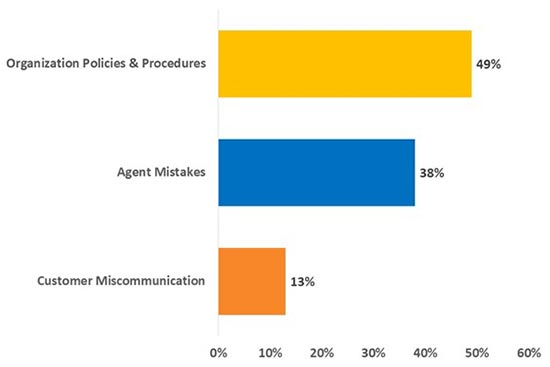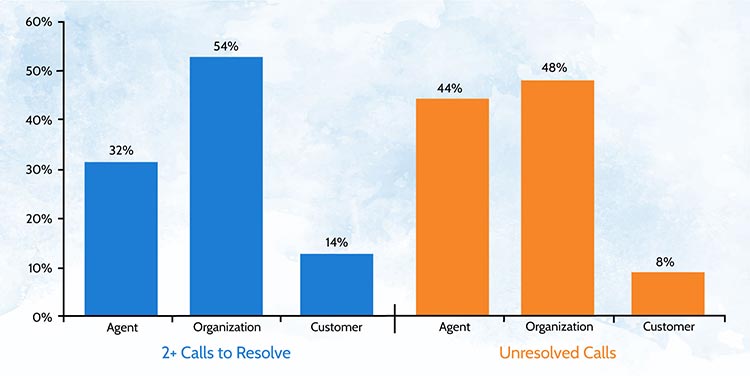What is a Good FCR Rate?
Before we share "what is a good First Call Resolution (FCR) rate insights," we need to emphasize the importance of FCR. The FCR metric should be considered the most important call center metric of all metrics and KPIs due to the positive impact on a call center's operating cost efficiency and customer service delivery effectiveness. As a result, FCR is the most-watched call center industry metric.
At SQM Group, the question we get asked from our clients the most when we measure their call center's customer service is "what is a good FCR rate?" Based on measuring and benchmarking over 500 leading North American call centers for 25 years, our view using the post-call surveying method is that a good FCR rate standard is 70% to 79%. Call centers with a FCR rate of 69% or below are considered at the low end and need to improve their FCR performance. However, the world-class FCR rate standard is 80% or higher, and many call centers strive to achieve it.

It's always good to have a benchmark to compare yourself and your FCR rates to other call centers. This gives you an idea of how your FCR rate compares to other call centers, specific industries, and world-class call centers. However, finding a valid FCR benchmark for a good First Call Resolution rate can be challenging.
The value of measuring the FCR rate using a Voice of the Customer (VoC) post-call/contact survey (e.g., phone, email) is that you can standardize the method to benchmark the FCR rate accurately. SQM's view is that the post-call survey method is the only way to accurately benchmark the FCR rate. In addition, conducting a post-call survey allows a call center to gain additional insights into why FCR was not achieved and the repeat call reasons that need improvement from a customer's perspective.
The below graph shows the First Call Resolution rate distribution for the North American call center industry breakdown for the organizations that we benchmarked their FCR rate. It is important to emphasize that the FCR rate varies by call types (e.g., billing, claims, orders, inquiries, technical), lines of business, segments, geography, demographics, and industries.
Our FCR benchmark research shows that only 5% of call centers perform at the world-class FCR rate standard of 80%. World-class performing call centers create higher customer referrals and retention. For example, every 1% improvement in the FCR rate increases the interactional Net Promoter Score by 1.4 points for the average call center. Furthermore, when FCR is achieved, 95% of customers will continue to do business with the organization. In general, the higher the FCR rate, the better.
In addition, 46% of call centers perform at the Good FCR rate standard, between 70% and 79%. Based on a post-call survey method, the call center Industry benchmark average for the FCR rate is 71%. This means that 29% of customers have to call back the organization to resolve the same interaction. The good FCR rate standard varies according to the call reason, line of business and industry, etc. Therefore a good FCR rate depends on what kind of service or product you offer. For example, companies that provide technical products will have a harder time resolving issues on the first call than eCommerce companies.
Moreover, 49% of call centers need improvement because the FCR rate is lower than 70%. In general, for call centers with an FCR rate below 70%, there is a huge opportunity to improve customer service effectiveness and lower operating cost efficiency. For example, for every 1% improvement in FCR, there is a 1% improvement in customer satisfaction. In addition, for every 1% improvement in FCR, you reduce your operating costs by 1%. As a result, a 1% improvement in their FCR rate equals $286,000 in annual operational savings for the average midsize call center.

Call Center FCR Benchmarks By Industry
SQM Group has been measuring, benchmarking, and tracking FCR to help leading North American call centers improve First Call Resolution and customer service for over 25 years. We benchmark the FCR rate with over 500 leading North American call centers annually using a Voice of the Customer (VoC) measuring and benchmarking approach.
We use a standardized approach for measuring First Call Resolution with all FCR benchmarking participants. Our standardized FCR measurement practice is considered the gold standard for measuring and benchmarking FCR consistently and accurately. To ensure the FCR benchmark is accurate and helpful for call center managers to compare to their call centers, we used the below practices:
- FCR benchmarks comparison to industry peers, average, and world-class North American call centers
- High-level call center FCR and repeat call metrics are reported
- The FCR rate is calculated based on two customer survey questions for the external post-call survey measurement
- Only inbound customer service call centers are benchmarked
- We have included only industries with more than 10 call centers benchmarked
- A minimum sample size of 400 surveys per call center participant
- Post-call/email survey FCR questions are the same for all participants
- Surveys are conducted within one business day of customer interaction
- Post-call surveys are conducted using SQM's in-house telephone survey agents
- QA auditors and speech recognition is used to ensure survey accuracy
Call Center FCR Benchmark Results By Industry
In this report, we share high-level FCR benchmark results by industry. A best practice is to benchmark your call center's FCR rate against industry peer's average, highest peer call center, call center industry average, and world-class call center versus just industry peer's call center average. Now, with that in mind, let's review the call center FCR benchmark results by industry.
SQM - 2022 FCR Benchmark By Industry

The aggregated FCR average across all industries was 71%. The FCR rate ranges from 40% to 91%. It is surprising to see the average FCR was only 1% lower than the previous year, given that 87% of agents work from home (WFH), and there has been a 35% annual agent turnover. WFH and agent turnover percentages are approximately double from pre-covid.
Retail, Not for Profit, and Insurance industries' call centers lead the pack with a good FCR rate average of 75%. Interestingly, all industries have a company's call center performing at the world-class FCR standard of 80% or higher FCR rate except for the Telco industry. Given that just about all industries have a world-class FCR performing call center, it would support the argument that complex call handling call centers can achieve world-class FCR performance.
Moreover, it is not surprising that retail call centers are the highest performing industry for the FCR rate, given lower call complexity. However, it is pretty impressive for the insurance industry call centers to perform at a high FCR rate, given that they have moderate to high call complexity.
Government, energy, health insurance, and financial industries' call center's FCR rate can be defined as moderate or lower-level good FCR rate. These industries' call center FCR rate has seen very little change in the last five years. Furthermore, these industries are considered bellwether industries for new people, processes, and technology advancements that positively impact all call centers.
Tech support and telecommunication industries' call center's FCR rate continues to perform at the needs improvement for the FCR rate. However, in our over 25 years of measuring the FCR rate for the telecommunication industry, we have never had a world-class performing telco. Therefore, this represents an excellent opportunity for a telco call center to improve FCR to assist them in delivering great enterprise-wide customer experiences.
FCR Performance Comparison Call Type
The below chart shows FCR performance comparison by call type. For example, the data shows the highest FCR rates are general inquiries at 74%, account maintenance at 73%, orders at 72%, billing at 71%, technical at 63%, claims at 59%, and complaints with the lowest FCR at 47%.
For many call centers, inquiries, account maintenance, orders, and billing have low to moderate call type complexity and, therefore, have higher than average FCR performance. Conversely, billing, technical, claims, and complaint call types have moderate to high call complexity and, therefore, have lower than average FCR performance. We also want to emphasize that we have call centers that can achieve world-class FCR standards for all call types except for the complaint calls.
As a general rule of thumb, SQM uses average handle time (AHT), new hire and existing agent training, call flow, and desktop applications to determine call complexity. Another essential component of call complexity is the emotional aspect of the call, especially for customers who are calling the call center with a complaint.
SQM's research shows that the AHT (talk time and wrap-up time) for the call center participating in our benchmarking study is 589 seconds, resulting in an 8% increase from the previous year. Furthermore, the FCR rate is impacted by call length. For example, the FCR rate for the 1 to 3-minute call length is 76% versus the 15-minute call length, where the FCR rate is 62%. Most call lengths are between 5 to 10 minutes for the call center industry. For those call lengths, the FCR rate is 71%.

Root Causes Hindering Achieving High FCR
Another question at SQM we are often asked is, "what hinders call centers from improving or achieving a high FCR rate." There are many challenges to improving or achieving a high First Call Resolution rate. A starting point is to conduct root cause analysis for Non-FCR customer interactions by identifying and analyzing repeat call reasons.
Identifying and Analyzing Repeat Call Reasons Using the Following Methods:

- Identify repeat call reasons by using a post-call survey and asking customers the reason why their inquiry or problem was not resolved, and then the feedback is tagged for repeat call reason
- Analyzing why calls are not resolved on the first call
- Examining the trends from your external and internal FCR measurement methods
- Reviewing call types (e.g., technical, claims, orders, inquires) that have the highest repeat calls
- Determining the targeted opportunities for reducing repeat call reasons
- Analyze why customers are not satisfied with the solution
- Determine why do calls need to be transferred
- Examine why do calls need to be escalated to another person or manager
Once Repeat Call Reasons are Identified, Analyze the Root Causes, Such as:

- Are there organizational policies and procedures that hinder FCR?
- Are there customer issues or confusion that hinder FCR?
- Do agent desktop applications or lack of resources hinder FCR?
- Do agents have the skills, knowledge, and abilities to resolve calls?
- Do agents have the necessary coaching to resolve calls?
- Do agents have the motivation and recognition to resolve calls?
- Do your agent call handling (e.g., talk time, wrap up, transfers, hold, etc.) practices hinder FCR?
- Who is the source of error (e.g., agent, customer, organization) for non-FCR calls?
Non-FCR Calls Source of Errors
SQM's research shows that the source of error (SoE) for non-FCR calls is the agent 38% of the time, the customer 13%, and the organization 49%.
Furthermore, our research shows that most FCR improvement comes from reducing agent and customer SoE. Therefore, the quickest way to improve FCR for call centers is to reduce agent SoE. We have clients who have experienced FCR improvement due to reducing the organizational SoEs, but this FCR improvement approach tends to be the exception and not the rule. Also, when FCR improvement comes from lowering organizational SoE, it takes a long time in most cases.
However, given that the organizational SoE is 49% for non-FCR calls, it is essential to collaborate with other functions to identify the FCR failure points and develop the necessary action plans to improve. If your call center is looking for quick wins, in most cases, it is better to focus on agent and customer SoE opportunities and then organizational SoE opportunities.

The below figure shows that for calls that are resolved but took two or more calls, the organization tends to be the source of error, most often at 54%. The organization SoE is substantially higher than when the agent SoE which is 32% for two-plus calls to resolve an interaction, was required. However, when the call is unresolved, the agent is the SoE 44% of the time.
Agents must understand they are the primary source of error when calls go unresolved. However, it has been SQM's experience that agents believe that the organization is the source of error most of the time, not them. Therefore, agents need to be held accountable for call resolution, especially when you consider the call center the last line of defense to prevent customers from defecting.
NON-FCR SOURCE OF ERROR BREAKDOWN

Moreover, SQM research shows root causes for the top five repeat call reasons that hinder delivering great customers service and First Call Resolution are:
- A customer needed to check or verify the status of their unresolved interaction
- The customer got disconnected while being on hold
- Agent lacked the knowledge to resolve the interaction
- The customer request was not completed
- The customer was redirected to another company
Achieving high or improving First Call Resolution requires call center leadership to be highly committed to enhancing the support experience for agents, customers, and the organization. Furthermore, it is critical to determine the root causes for SoEs and the repeat call reasons for non-FCR calls.
FCR Improvement Action Plan
According to Gartner stat: 95% of companies collect customer feedback. Yet only 10% use the feedback to improve, and only 5% tell customers what they are doing in response to what they heard. If customers take the time to provide feedback to help call centers improve service, organizations should close the loop with customers. Put simply, after receiving the customer feedback, action it.
The VoC closed-loop improvement process is a well-accepted business practice for developing a FCR action plan for continuously improving FCR. After you have measured your FCR performance and determined the root causes of repeat call reasons, you will need to develop a plan of action (e.g., who, what, why, when, and how) to improve FCR.
To ensure that FCR continuously improves, a call center should use an - Identify, Develop, Check, and Act (IDCA) Closed-loop Improvement Cycle to measure, benchmark, and improve FCR performance. The four steps of the FCR-IDCA Closed-loop Improvement Cycle consist of:
1. Identify - repeat call reasons to improve by measuring FCR and Csat performance
2. Develop - a solution and implement a test pilot to reduce repeat call reasons
3. Check - to see if the test pilot was successful by measuring changes in FCR
4. Act - on customer feedback by implementing a standardized improvement plan for reducing repeat call reasons for the entire call center

mySQM™ Customer Service QA Software
Find out why over 500 leading North American call centers trust mySQM™ Customer Service QA Software as a best practice to measure and improve First Call Resolution. Our software provides First Call Resolution insights by capturing and reporting external (e.g., post-call surveys) and internal (e.g., call data, quality assurance) data, all in one powerful First Call Resolution software platform. Our high-value software is specifically built to help call centers improve their operating costs. As a result, our client's average ROI is 450%, and the payback period is less than three months.
Quick Related Links
First Call Resolution Definition First Call Resolution PPT First Call Resolution Benefits
First Call Resolution Strategies First Call Resolution Actioning VoC Data Call Center VoC What is a Good FCR Rate? VoC Closed-loop Top 10 CX Metrics

